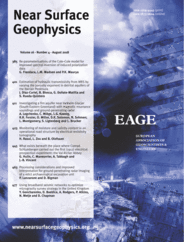-
oa Re‐parameterisations of the Cole–Cole model for improved spectral inversion of induced polarization data
- Source: Near Surface Geophysics, Volume 16, Issue 4, Jul 2018, p. 385 - 399
-
- 31 Jan 2017
- 28 Nov 2017
- 27 Jul 2018
Abstract
The induced polarization phenomenon, both in time domain and frequency domain, is often parameterised using the empirical Cole–Cole model. To improve the resolution of model parameters and to decrease the parameter correlations in the inversion process of induced polarization data, we suggest here three re‐parameterisations of the Cole–Cole model, namely the maximum phase angle Cole–Cole model, the maximum imaginary conductivity Cole–Cole model, and the minimum imaginary resistivity Cole–Cole model. The maximum phase angle Cole–Cole model uses the maximum phase φmax and the inverse of the phase peak frequency, τφ, instead of the intrinsic charge‐ability m0 and the time constant adopted in the classic Cole–Cole model. The maximum imaginary conductivity Cole–Cole model uses the maximum imaginary conductivity instead of m0 and the time constant τσ of the Cole–Cole model in its conductivity form. The minimum imaginary resistivity Cole–Cole model uses the minimum imaginary resistivity instead of m0 and the time constant τρ of the Cole–Cole model in its resistivity form.
The effects of the three re‐parameterisations have been tested on synthetic time‐domain and frequency‐domain data using a Markov chain Monte Carlo inversion method, which allows for easy quantification of parameter uncertainty, and on field data using 2D gradient‐based inversion. In comparison with the classic Cole–Cole model, it was found that for all the three re‐parameterisations, the model parameters are less correlated with each other and, consequently, better resolved for both time‐domain and frequency‐domain data. The increase in model resolution is particularly significant for models that are poorly resolved using the classic Cole–Cole parameterisation, for instance, for low values of the frequency exponent or with low signal‐to‐noise ratio. In general, this leads to a significantly deeper depth of investigation for the , , and parameters, when compared with the classic m0 parameter, which is shown with a field example. We believe that the use of re‐parameterisations for inverting field data will contribute to narrow the gap between induced polarization theory, laboratory findings, and field applications.



